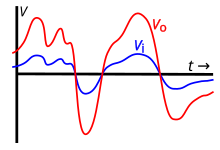
Back كسب كهربائي Arabic গেইন (ইলেকট্রনিক্স) Bengali/Bangla Pojačanje (elektronika) BS Guany (electrònica) Catalan Zisk (elektrotechnika) Czech Verstärkung (Physik) German Απολαβή Greek Ganancia (electrónica) Spanish Võimendustegur Estonian Irabazi (elektronika) Basque
In electronics, gain is a measure of the ability of a two-port circuit (often an amplifier) to increase the power or amplitude of a signal from the input to the output port[1][2][3][4] by adding energy converted from some power supply to the signal. It is usually defined as the mean ratio of the signal amplitude or power at the output port to the amplitude or power at the input port.[1] It is often expressed using the logarithmic decibel (dB) units ("dB gain").[4] A gain greater than one (greater than zero dB), that is, amplification, is the defining property of an active component or circuit, while a passive circuit will have a gain of less than one.[4]
The term gain alone is ambiguous, and can refer to the ratio of output to input voltage (voltage gain), current (current gain) or electric power (power gain).[4] In the field of audio and general purpose amplifiers, especially operational amplifiers, the term usually refers to voltage gain,[2] but in radio frequency amplifiers it usually refers to power gain. Furthermore, the term gain is also applied in systems such as sensors where the input and output have different units; in such cases the gain units must be specified, as in "5 microvolts per photon" for the responsivity of a photosensor. The "gain" of a bipolar transistor normally refers to forward current transfer ratio, either hFE ("beta", the static ratio of Ic divided by Ib at some operating point), or sometimes hfe (the small-signal current gain, the slope of the graph of Ic against Ib at a point).
The gain of an electronic device or circuit generally varies with the frequency of the applied signal. Unless otherwise stated, the term refers to the gain for frequencies in the passband, the intended operating frequency range of the equipment. The term gain has a different meaning in antenna design; antenna gain is the ratio of radiation intensity from a directional antenna to (mean radiation intensity from a lossless antenna).

- ^ a b Graf, Rudolf F. (1999). Modern Dictionary of Electronics (7 ed.). Newnes. p. 314. ISBN 0080511988.
- ^ a b Basu, Dipak (2000). Dictionary of Pure and Applied Physics. CRC Press. p. 157. ISBN 1420050222.
- ^ Bahl, Inder (2009). Fundamentals of RF and Microwave Transistor Amplifiers. John Wiley and Sons. p. 34. ISBN 978-0470462317.
- ^ a b c d White, Glenn; Louie, Gary J (2005). The Audio Dictionary (3 ed.). University of Washington Press. p. 18. ISBN 0295984988.
© MMXXIII Rich X Search. We shall prevail. All rights reserved. Rich X Search


